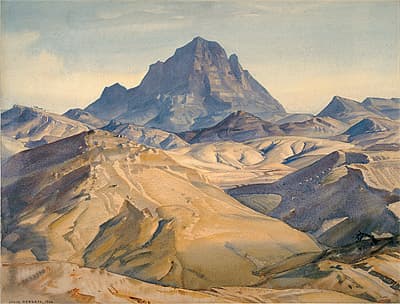Hans
HEYSEN
Germany
1877
–
Australia
1968
Australia from 1884; Europe, England 1899-1903
The land of the Oratunga
1932
watercolour on paper
Frame
79.5 (h)
x 94.7 (w)
x 5.0 (d)
cm
South Australian Government Grant 1937, Art Gallery of South Australia
Patawarta Hill, five kilometres north of Blinman, is one of the most striking formations in the Northern Flinders Ranges. Its distinctive pyramid-like form was a magnetic subject for Heysen, one to which he systematically returned again and again. Its opulent purple and blue contrasts with the crystalline pink and orange of his other obsessively repeated pyramid, in the Brachina Gorge. He produced numerous drawings of Patawarta—preliminary sketches and finished charcoals—as well as paintings. The most celebrated is this breathtaking watercolour, The Land of the Oratunga, bearing a resonantly Aboriginal name, and unique for its near-total absence of vegetation. A single, small blackened tree-skeleton leans in the foreground, lower right, and thereby emphasises the absence.
Heysen’s view is taken from the ruins of Artimore homestead and presents the mountainous peak rising high above its foothills. The watercolour was in all probability finished in the studio, and resulted from various on-the-spot studies, including sketches in wash[1] and a fine pencil study, Patawarta Hill 1928, which record preliminary ideas. By 1929 Hevsen had also used these to develop the composition into an oil painting, Patawarta: Land of the Oratunga, and by 1930 there were finished charcoal drawings.[2]
In this later and very different watercolour Heysen has achieved a remarkable sense of form through the use of colour. Contrasting combinations of purple, blue, green and orange, adventurous in their boldness, undulate between light and dark. By placing one translucent wash over another, Heysen has created a third colour for the shadow. For instance, instead of using black for shadow in the middle-distance hill formations, Heysen chose contrasting combinations of green for the lighter areas and purple for the shadows. Likewise, in the foreground, orange is contrasted with a purple for shadow. This creates the effect of flashes of colour, somewhat comparable to shot silk, and is a most vivid depiction of light and atmosphere.
The Land of the Oratunga exemplifies how Heysen found watercolour the most suitable medium for the arid and austere Flinders Ranges. In contrast to his earlier oil painting of the same subject, this watercolour is a more resolved composition, freer in style and handling of the medium. The result is extraordinarily dramatic and rich in colour. Mesmerising rolls of land rise, climax with the spectacular ancient form of Patawarta Hill and, in Heysen’s own words, resemble ‘arrested waves on the verge of breaking’.[3]
Rebecca Andrews
© Art Gallery of South Australia, Adelaide, 2008
Andrews, Hans Heysen, exhibition book, Art Gallery of South Australia, Adelaide, 2008
[1] Such as Patawarta Hill, c 1928–33 (AGSA, accession no 711HH1170)
[2] As in the charcoal drawing Mt Patawarta, 1930 (AGSA, accession no20075D12)
[3] Heysen letter to Lionel Lindsay, 1928; also quoted in Lionel Lindsay, ‘Heysen’s recent watercolours’, Art in Australia, series 3, no 24, June 1928 (unpaginated)
